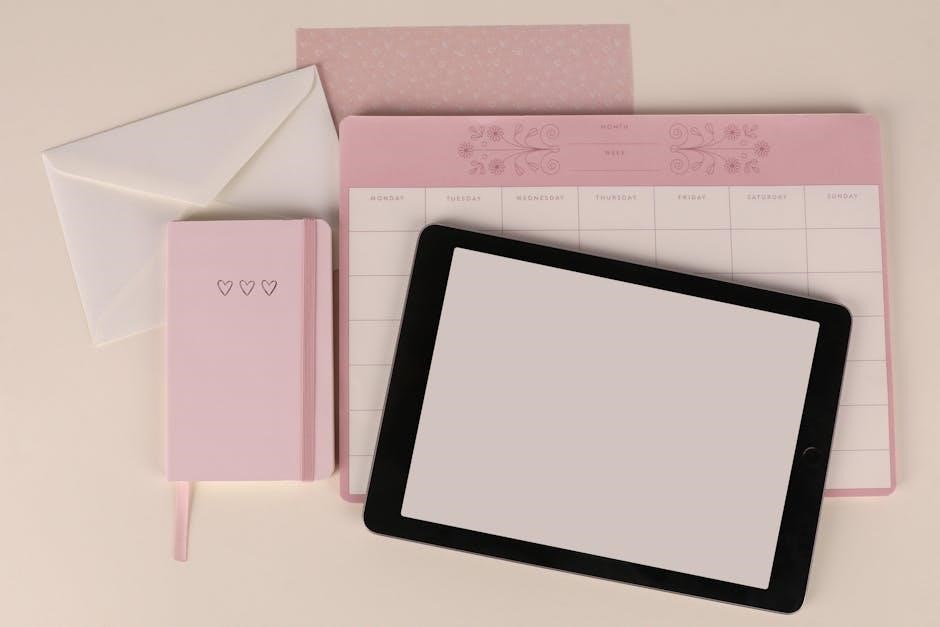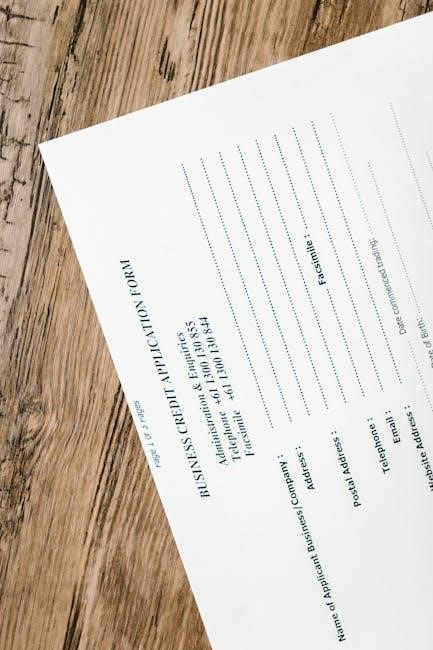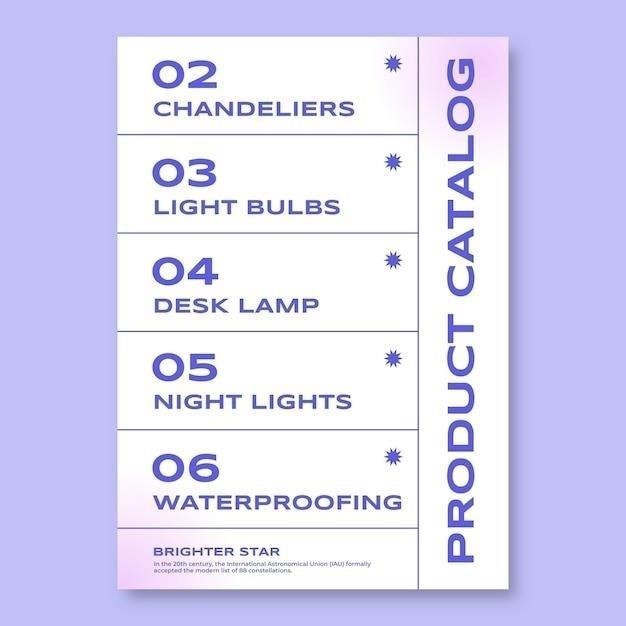A babysitter instructions template is a practical tool designed to help parents organize essential information for caregivers. It ensures clarity, safety, and peace of mind.
What is a Babysitter Instructions Template?
A babysitter instructions template is a customizable document designed to provide caregivers with essential details about a child’s needs, routines, and household rules. It typically includes sections for emergency contacts, medical information, feeding schedules, bedtime routines, and favorite activities. This tool ensures that babysitters are well-prepared to handle daily care and unexpected situations. Parents can tailor the template to their family’s specific requirements, ensuring clarity and consistency. By organizing critical information in one place, it simplifies communication and offers peace of mind for parents while they’re away. Many free downloadable templates are available online, making it easy to create and print.
Why is it Important to Have a Babysitter Instructions Template?
A babysitter instructions template is crucial for ensuring a child’s safety, comfort, and routine consistency. It provides caregivers with clear guidance, reducing confusion and stress. By outlining emergency contacts, medical details, and daily schedules, it helps babysitters respond effectively in any situation. This tool also offers parents peace of mind, knowing their child’s needs are met. Customizable templates allow families to tailor information to their specific requirements, making it a versatile and essential resource for smooth communication. Having a well-organized template ensures that critical details are readily available, fostering trust and reliability between parents and babysitters.
Key Components of a Babysitter Instructions Template
A babysitter instructions template typically includes emergency contacts, medical information, schedules, feeding guidelines, bedtime routines, favorite activities, and household rules to ensure smooth childcare.
Emergency Contact Information
Including emergency contact information is crucial for a babysitter to act quickly in unexpected situations. This section should list parents’ phone numbers, alternative emergency contacts, and any relevant medical professionals. Additionally, including numbers like poison control or the local hospital provides immediate access during critical moments. Clearly organizing this information ensures the babysitter can respond efficiently without confusion. It’s important to double-check the accuracy of all contact details and make sure they are easily accessible, perhaps highlighted or placed prominently for visibility. This step ensures the babysitter can handle emergencies with confidence and speed.
Medical Information and Allergies
This section is vital for ensuring the babysitter is aware of any medical conditions, allergies, or special needs your child may have. It should include details about any medications your child is currently taking, dosage instructions, and any known allergies to foods, substances, or environmental factors. Additionally, it’s important to list emergency procedures, such as what to do in case of an allergic reaction or seizure. Including contact information for your child’s doctor and any relevant medical insurance details ensures the babysitter can act quickly and confidently in a medical situation. This information helps protect your child’s health and well-being.
Child’s Schedule and Routine
This section outlines the child’s daily schedule, including feeding times, nap schedules, and bedtime routines. It should detail any specific activities, such as homework, playtime, or outdoor activities, and the preferred order of events. Including meal preferences, snack options, and any limitations helps the babysitter maintain consistency. Additionally, noting wake-up and bedtime procedures ensures the child’s routine remains uninterrupted. This section is crucial for helping the babysitter understand and manage the child’s daily flow, ensuring a smooth and predictable environment that supports the child’s well-being and behavior.
Feeding Instructions
This section provides detailed guidance on the child’s dietary needs, including favorite foods, allergies, and any restrictions. It should list preferred snacks, meal times, and portion sizes. Specify if there are any foods to avoid due to allergies or preferences. Include information on how to prepare meals, such as heating instructions or special recipes. If applicable, note any supplements or medications that must be administered with food. Also, mention where to find utensils, plates, and storage for leftovers. This ensures the babysitter can provide healthy, safe, and enjoyable meals for the child.
Bedtime Routine
This section outlines the child’s bedtime schedule, including the specific time for sleep and any pre-bedtime activities, such as reading, brushing teeth, or a warm bath. Detail the steps needed to help the child wind down, like dimming lights or playing soothing music. List any comfort items, such as a favorite blanket or stuffed animal, that the child relies on for sleep. Include instructions for maintaining a consistent routine to ensure the child feels secure and develops healthy sleep habits. Specify any special requests or rituals that are part of the child’s bedtime process.
Favorite Activities and Toys
This section lists the child’s preferred activities, such as drawing, reading, or outdoor games, and specifies their favorite toys or objects. Include details about any particular games or routines the child enjoys, as well as the location of toys and materials. Mention if there are any toys the child should avoid or if certain activities require supervision. This helps the babysitter engage the child in meaningful play and ensures the child feels comfortable and entertained. Providing this information allows the babysitter to tailor activities to the child’s interests, fostering a positive and enjoyable environment.
Household Rules
This section outlines the family’s specific rules and expectations for the babysitter to follow. It includes guidelines like screen time limits, food restrictions, and toy usage. Specify rules about cleaning up, quiet hours, or guest policies. Mention if certain areas of the house are off-limits or require supervision. Provide details about acceptable snacks and mealtimes, as well as any dietary restrictions. Also, note if there are rules about outdoor play or electronic device usage. This ensures the babysitter understands and enforces the household’s standards, maintaining consistency and safety while you’re away. Clear communication helps prevent misunderstandings.

Daily Routine Details
This section breaks down the child’s schedule, including mealtimes, activity periods, and rest intervals. It ensures the babysitter maintains a consistent and predictable daily structure for the child.
Morning Routine
The morning routine section outlines the child’s wake-up time, breakfast preferences, and any specific morning instructions. It includes details like dressing, brushing teeth, and morning medications, ensuring the babysitter can maintain a smooth start to the day. This section also covers any unique requirements, such as special diets or allergies, and provides guidance on engaging the child in positive morning activities. By detailing these steps, parents can ensure their child’s morning transitions remain consistent and stress-free, even in their absence. This clear structure helps the babysitter understand and follow the family’s daily practices effectively.
Afternoon Routine
The afternoon routine section provides a detailed schedule for post-lunch activities, ensuring the child stays engaged and comfortable. It includes specifics like outdoor playtime, quiet time, or homework assistance, along with snack preferences and any allergies. This section also outlines expected activities, such as reading, crafts, or screen time limits, and notes any additional instructions for special needs or energy levels. By structuring the afternoon, parents help the babysitter maintain a balanced and enjoyable environment, ensuring the child’s day remains productive and fun. This section is tailored to keep the child active and entertained while adhering to family rules and routines.
Evening Routine
The evening routine section outlines the steps to ensure a smooth transition toward bedtime. It includes details like dinner time, homework completion, and screen time limits. Parents can specify activities like reading or relaxation to help the child wind down. This section also covers bedtime schedules, including tuck-in times and any calming routines. Additional notes may include preferences for pajamas, brushing teeth, or a final snack. The babysitter should follow these instructions to maintain consistency and help the child prepare for a restful night. Clear guidelines ensure the evening flows smoothly and the child feels secure and comfortable.

Safety Measures
This section provides crucial information to ensure the child’s safety, including emergency preparedness and securing the environment. It helps prevent accidents and ensures quick responses.
Emergency Preparedness
This section ensures the babysitter is ready for emergencies by listing essential contacts, first aid instructions, and evacuation plans. It includes emergency phone numbers, such as 911, poison control, and nearby hospitals. Parents should also provide details about fire extinguishers, smoke detectors, and escape routes. Including a first aid kit checklist and any specific medical instructions for the child is crucial. The template may also outline steps for handling minor injuries, allergic reactions, or natural disasters. By organizing this information clearly, parents can ensure the babysitter responds quickly and effectively in critical situations, providing peace of mind for the whole family.
Securing the Environment
This section focuses on ensuring the home is safe for the child and babysitter. It includes tips for securing doors, windows, and potentially hazardous areas. Parents should list locations of safety devices like locks, latches, and security cameras. Instructions for storing cleaning supplies, medications, and sharp objects out of reach are essential. The template may also cover electrical outlet covers and furniture anchoring to prevent accidents. By organizing this information, parents can create a secure environment, reducing risks and giving the babysitter clear guidelines to maintain safety while supervising the child. This ensures a worry-free experience for everyone involved.

Communication Guidelines
Clear and accessible communication ensures the babysitter can reach parents quickly and stay informed about the child’s needs, fostering trust and confidence in caregiving.
How to Reach Parents
Include clear contact information for parents, such as primary and secondary phone numbers, to ensure the babysitter can reach them quickly in case of an emergency or concern. Specify preferred communication methods, like calling or texting, and provide alternative options, such as email or messaging apps, if needed. Note the best times to contact parents and any time zone differences if they are traveling. Additionally, include details about the parents’ location while away, if relevant, to help the babysitter understand availability. This ensures seamless communication and peace of mind for everyone involved.
Daily Reporting
A daily reporting section in a babysitter instructions template helps parents stay informed about their child’s activities while they’re away. Include a log for the babysitter to note meals served, nap times, activities, and any milestones or issues that arose. This section ensures parents can review their child’s day and address any concerns promptly. It also provides a clear record of the babysitter’s responsibilities and performance. Many templates offer customizable fields to tailor the reporting to your family’s needs, making it easy for the babysitter to provide detailed, accurate updates. This fosters trust and ensures everyone stays on the same page.

Additional Resources
Discover free downloadable templates and checklists to create a comprehensive babysitter guide. Customize templates to fit your family’s needs for a personalized approach.
Templates and Checklists
Free downloadable templates and checklists are available to help parents create a comprehensive babysitter guide. These resources often include sections for emergency contacts, medical information, and daily routines. Parents can customize these templates to fit their family’s specific needs, ensuring all critical details are covered. Checklists provide a quick reference for sitters, covering essentials like feeding instructions and bedtime routines. Printable options are widely accessible, allowing parents to organize information neatly; These tools not only save time but also ensure clarity and preparedness for caregivers. Using templates and checklists helps parents feel confident their child’s needs are met while they’re away.
Customization Tips
To tailor your babysitter instructions template to your family’s needs, start by personalizing each section with specific details. For example, list emergency contacts, medical information, and your child’s routine. Use editable templates in Microsoft Word or Google Docs to modify sections as needed. Add personal notes about your child’s preferences, such as favorite toys or comfort items. Include photos of your child for quick identification. Consider adding a section for household rules or specific instructions for pets. Regularly update the template to reflect changes in your child’s needs or household dynamics. This ensures the information remains relevant and helpful for caregivers.

Free Downloadable Templates
Find free downloadable babysitter instructions templates online, offering customizable and editable formats in Word, Google Docs, or PDF. These templates are designed to simplify organization.
Where to Find Templates
Free babysitter instructions templates are widely available online. Websites like Pinterest, parenting blogs, and creative platforms offer downloadable templates in Word, Google Docs, or PDF formats. Many sites provide customizable designs, ensuring you can tailor the template to your family’s needs. Popular sources include theincrementalmama.com, Paper Trail Design, and other parenting resources. These templates are designed to be user-friendly, covering essential sections like emergency contacts, routines, and medical information. Simply search for “free babysitter instructions template” to find numerous options. Download, edit, and print them easily.
How to Use Templates
Using babysitter templates is straightforward. Start by downloading a template from a reliable source. Open it in Microsoft Word or Google Docs to customize the content. Fill in sections like emergency contacts, medical info, and routines. Tailor feeding instructions and bedtime procedures to your child’s needs. Save the document and print it for the sitter. Ensure all details are clear and accessible. This organized approach ensures the babysitter has all necessary information, providing peace of mind for parents. Regularly update the template as your child’s needs change. Keep a digital copy for easy access and sharing with caregivers.

Legal Considerations
A babysitter instructions template ensures compliance with legal requirements, protecting both parents and sitters. Include consent forms, emergency contacts, and clear contract agreements to avoid disputes;
Consent Forms
Consent forms are essential to ensure legal protection for both parents and babysitters. They outline permission for medical treatment, emergency decisions, and authority to care for the child. Parents should include signatures, dates, and specific details about the child’s medical needs. These forms also clarify liability and responsibilities, reducing potential legal disputes. Easily customizable templates are available online, allowing parents to tailor consent forms to their family’s specific requirements. Ensuring these documents are up-to-date and accessible provides peace of mind for all parties involved. Regular updates are recommended to reflect any changes in the child’s health or caregiver arrangements.
Contract Agreements
A contract agreement formalizes the relationship between parents and babysitters, outlining expectations, responsibilities, and compensation. It should include payment terms, work hours, duties, and termination policies. Parents can customize templates to reflect specific needs, such as confidentiality clauses or emergency procedures. Including a clear description of the babysitter’s role ensures mutual understanding. Templates are widely available online, offering flexibility for parents to adapt agreements to their unique circumstances. This legal document provides security for both parties, clarifying expectations and reducing potential disputes. Regular reviews and updates are recommended to maintain relevance and compliance with local laws.

Organizing the Information
Organizing information in a babysitter template ensures clarity and accessibility. Structured sections help caregivers quickly find essential details, reducing confusion and stress during emergencies or daily routines.
Clarity and Accessibility
Clarity and accessibility are crucial in a babysitter instructions template. A well-organized document ensures that all vital information is easy to locate and understand. Using clear headings, bullet points, and concise language helps sitters quickly find details during emergencies or daily routines. Ensuring the template is visually appealing and free from clutter enhances readability. Additionally, placing the document in an easily accessible location, such as on the fridge or in a designated folder, guarantees that caregivers can refer to it without hassle. Clear instructions reduce confusion and errors, providing peace of mind for parents.
Ensuring Completeness
Ensuring completeness in a babysitter instructions template is vital for the caregiver to handle all situations effectively. The template should cover emergency contacts, medical information, routines, feeding instructions, bedtime procedures, favorite activities, household rules, and safety measures. Each section must be thoroughly detailed to avoid ambiguity. Regularly reviewing and updating the template ensures all information remains accurate and relevant. This comprehensive approach reduces confusion and provides peace of mind for parents, knowing their child’s needs are fully addressed. A complete template is essential for a smooth and stress-free experience for both parents and sitters.

How to Use the Template
Download the template, customize it with your family’s details, and print or share it digitally with the babysitter. Ensure all sections are filled clearly and concisely.
Step-by-Step Guide
Download the template from a trusted source and open it in an editable format like Microsoft Word or Google Docs.
Fill in all essential sections, such as emergency contacts, medical information, and daily routines.
Customize the template to include specific details about your child’s preferences and household rules.
Review the document for clarity and completeness before sharing it with the babysitter.
Print or digitally share the template, ensuring the babysitter understands each section.
Discuss the template with the babysitter to address any questions or concerns.
Keep a copy handy for future use and update it as needed.
Practical Tips
Use a clear and concise format to ensure readability. Include bullet points for quick reference. Laminate the document for durability. Attach emergency contact details prominently. Highlight critical medical information. Provide a section for daily routines and preferences. Add notes on household rules and safety measures. Ensure the sitter understands all instructions before your departure. Regularly update the template as your child’s needs change. Keep a digital backup for easy access. Discuss the template with the sitter to clarify any questions. This approach ensures smooth communication and peace of mind for parents.

Customizing the Template
Personalize the template with your child’s routines, preferences, and medical information. Tailor sections for feeding, bedtime, and activities. Include safety measures and household rules for clarity and accessibility.
Tailoring to Family Needs
Customizing the babysitter instructions template to your family’s specific needs ensures the sitter understands your child’s routines, preferences, and any medical conditions. Include details like feeding schedules, bedtime rituals, and favorite activities. Add emergency contact information, allergies, and household rules to maintain safety and consistency. Tailor sections for daily routines, such as morning, afternoon, and evening activities, to help the babysitter follow your family’s unique rhythm. This personalization ensures the sitter can care for your child effectively, providing peace of mind for parents while they are away.
Benefits of Using a Template
Using a babysitter instructions template provides peace of mind, ensuring consistency and clarity in caregiving. It builds trust with the sitter and guarantees all essential details are covered.
Peace of Mind
A babysitter instructions template offers parents peace of mind by ensuring all critical details are clearly communicated. It eliminates guesswork for the sitter and reduces anxiety for parents.
Knowing that emergency contacts, routines, and medical information are readily available helps parents feel confident in the sitter’s ability to handle any situation, allowing them to enjoy their time away worry-free.
Building Trust with the Babysitter
A babysitter instructions template fosters trust by providing clear, detailed information about your child’s needs and routines. This demonstrates your confidence in the sitter’s ability to care for your child effectively.
By organizing essential details, you show responsibility and consideration, which helps the babysitter feel prepared and respected. This transparency strengthens your relationship and ensures everyone is on the same page, creating a positive experience for both parents and the caregiver.
A babysitter instructions template is an invaluable resource for parents, ensuring their children’s safety and well-being while they’re away. By organizing critical information, it reduces stress and provides peace of mind. These templates are customizable, allowing families to tailor details to their unique needs. With free, downloadable options widely available, parents can save time and focus on what matters most. A well-prepared template fosters trust with caregivers and ensures seamless communication. Ultimately, it’s a practical solution that promotes safety, clarity, and confidence for all involved.


